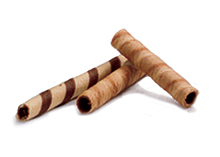Caramel color
Caramel color is a water-soluble food coloring derived from the controlled heat treatment of sugars. It is one of the oldest and most widely used food colorings, imparting a range of brown shades to food products and beverages. The color ranges from pale yellow to deep brown, depending on the specific type of caramel color and its application. It is commonly found in a variety of products, including soft drinks, sauces, baked goods, and alcoholic beverages.
Production[edit | edit source]
Caramel color is produced through a process known as caramelization, where sugars are heated to high temperatures in the presence of acids, alkalis, and salts. This process not only changes the color of the sugar but also creates various flavor compounds. There are four classes of caramel color, classified according to the reactants used in their production:
- Class I (E150a), also known as plain caramel, is made without any ammonium or sulfite compounds.
- Class II (E150b) is made with sulfite compounds but without ammonium compounds.
- Class III (E150c) is produced with ammonium compounds but without sulfites.
- Class IV (E150d) is made with both ammonium and sulfite compounds.
Each class of caramel color has distinct properties and applications, with Class IV being the most commonly used in beverages due to its stability in acidic conditions.
Health Concerns[edit | edit source]
The safety of caramel color has been evaluated by various international health authorities, including the World Health Organization's International Agency for Research on Cancer (IARC) and the U.S. Food and Drug Administration (FDA). While there have been concerns about the potential health effects of certain compounds formed during the production of caramel color, such as 4-methylimidazole (4-MEI), these agencies have determined that caramel color is safe for consumption in the amounts typically used in food and beverages.
Regulation[edit | edit source]
The use of caramel color in food and beverages is regulated by various national and international agencies. In the United States, the FDA regulates caramel color under the Federal Food, Drug, and Cosmetic Act, requiring that it be used in accordance with good manufacturing practices and be safe for consumption. Similarly, the European Food Safety Authority (EFSA) oversees the use of caramel colors in the European Union, assigning specific E numbers to each class of caramel color.
Applications[edit | edit source]
Caramel color is used in a wide range of food products and beverages to achieve desired color and appearance. Its applications include:
- Coloring for soft drinks, particularly cola beverages, where it provides the characteristic brown hue.
- In brewing and distilling, caramel color is used to standardize the color of beers and spirits.
- As a colorant in sauces, gravies, and condiments, adding visual appeal to these products.
- In baked goods and confectionery, where it can provide both color and flavor enhancements.
Conclusion[edit | edit source]
Caramel color plays a significant role in the food and beverage industry, offering versatility in application and contributing to the sensory attributes of many products. Despite concerns about certain by-products of its production, it remains a widely used and accepted food additive under current regulatory standards.
Search WikiMD
Ad.Tired of being Overweight? Try W8MD's physician weight loss program.
Semaglutide (Ozempic / Wegovy and Tirzepatide (Mounjaro / Zepbound) available.
Advertise on WikiMD
|
WikiMD's Wellness Encyclopedia |
| Let Food Be Thy Medicine Medicine Thy Food - Hippocrates |
Translate this page: - East Asian
中文,
日本,
한국어,
South Asian
हिन्दी,
தமிழ்,
తెలుగు,
Urdu,
ಕನ್ನಡ,
Southeast Asian
Indonesian,
Vietnamese,
Thai,
မြန်မာဘာသာ,
বাংলা
European
español,
Deutsch,
français,
Greek,
português do Brasil,
polski,
română,
русский,
Nederlands,
norsk,
svenska,
suomi,
Italian
Middle Eastern & African
عربى,
Turkish,
Persian,
Hebrew,
Afrikaans,
isiZulu,
Kiswahili,
Other
Bulgarian,
Hungarian,
Czech,
Swedish,
മലയാളം,
मराठी,
ਪੰਜਾਬੀ,
ગુજરાતી,
Portuguese,
Ukrainian
Medical Disclaimer: WikiMD is not a substitute for professional medical advice. The information on WikiMD is provided as an information resource only, may be incorrect, outdated or misleading, and is not to be used or relied on for any diagnostic or treatment purposes. Please consult your health care provider before making any healthcare decisions or for guidance about a specific medical condition. WikiMD expressly disclaims responsibility, and shall have no liability, for any damages, loss, injury, or liability whatsoever suffered as a result of your reliance on the information contained in this site. By visiting this site you agree to the foregoing terms and conditions, which may from time to time be changed or supplemented by WikiMD. If you do not agree to the foregoing terms and conditions, you should not enter or use this site. See full disclaimer.
Credits:Most images are courtesy of Wikimedia commons, and templates, categories Wikipedia, licensed under CC BY SA or similar.
Contributors: Prab R. Tumpati, MD



